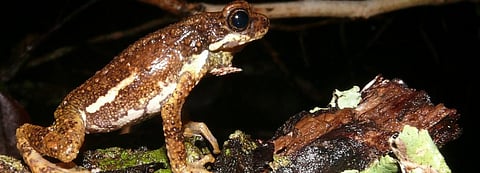

A Bengaluru-based non-profit is working to train and equip residents of villages in the Western Ghats stretching from Maharashtra to Tamil Nadu for mapping the range of an extremely rare species of toad.
The Metastring Foundation a citizen-based conservation non-profit, was awarded a grant of Rs 15 lakh for one year for its project on the Malabar Tree Toad (MTT), a very rare species of amphibian endemic to the Ghats.
The grant was awarded to the non-profit on November 14, 2019 in New Delhi by the Habitats Trust Grants, a programme designed to support work in the field in India to protect natural habitats and indigenous species.
The MTT is an endangered species that spends most of its life on trees, coming to the ground only during the first monsoon showers to mate.
The Western Ghats, where the MTT is found, is a biodiversity hotspot and is home to 179 recorded amphibian species, 80 per cent of which are not found anywhere else.
“The MTT was discovered in the nineteenth century. But it was missing for a long time. Then it was rediscovered from one or two spots. We had sporadic records from here and there. How do you study a species that is rarely seen by people and is endangered?” Harikrishnan S from Metastring told Down To Earth.
Metastring then came up with a project to involve people to monitor the toad as ‘no single scientists can go and do this’, added Harikrishnan.
The task before the team is challenging. For one, there are no estimates of how many MTTs are out there and in which places. “Once the baseline information is obtained about population and location, the citizen volunteers whom we train can keep an eye and immediately report if anything happens,” Harikrishnan said.
That ‘anything’ could be three things: habitat loss, climate change and Batrachochytrium dendrobatidis, a deadly fungus that has been decimating entire amphibian populations worldwide.
“It is all about empowering the local community with training as well as with equipment,” Ravi Chellam, chief executive of Metastring, said.
“We are also going to use the India Biodiversity Portal as a data aggregation platform,” he added.
Metastring is credited with developing the IBP, a free access platform where citizens can contribute, access and verify information on Indian biodiversity.
“The role of the IBP in the story of the MTT is interesting. Before we started aggregating data on the platform, we had three or four locations from where the toad was reported. Now we have nearly 50. So the power of crowd-sourced data and GIS-based platform is apparent. I think for many lesser-known species like the MTT, this is the best way of conservation,” Chellam said.
He also warned that climate change was looming as an ever-present threat to amphibians, both in India as well as other parts of the world.
“Amphibians by nature cannot tolerate greater levels of aridity. Their life cycle is tied closely to the monsoon. For instance, till late July this year, we were facing a drought and by mid-August, we were drowning in rain. How will these animals even breed without water?” he asked.